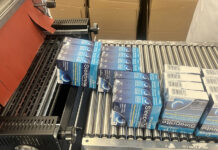RESPONDING to market demands for higher production output in clean room injection moulding facilities, Sumitomo (SHI) Demag has resolved one of the key challenges in pharmaceutical injection moulding – how components cascade from multi-cavity moulds on all-electric systems.
The company’s new ejector technology addresses the issue of plastic parts bouncing around, giving manufacturers the cycle time, precision and repeatability of a hydraulic system favoured in mass-production environments, whilst maintaining the ‘best in class’ clinical conditions.
As well as lowering energy consumption, all-electric machines are usually regarded as the safer choice for any manufacturer producing hygiene critical components. Until now, there was one snag: getting the components off the mould. Sumitomo (SHI) Demag has developed the ‘ejector’ technology to overcome this hurdle.
Dave Raine, Technical Sales Manager, said, “When producing essential yet disposable parts, which are commonplace in pharmaceutical packaging, mass production is critical. The equation is simple – the faster the machine pushes out quality components, the more likely you are to turn a profit.
“Quite literally, every second contributes towards profitability.” With this latest ejector development, customers can continue to opt for an all-electric system and maintain higher efficiency, without compromising on speed, product quality or machine performance.
Sumitomo (SHI) Demag has developed a new ejector and mould control algorithm, which synchronises the ejector forward speed with the mould open speed. This means that the point of ejection is effectively stationary. In other words, the ejector forward speed is exactly equal to mould open speed, allowing pharmaceutical components to be ejected without any inherent momentum.
“With our new ejector innovation this task can be performed with minimal input from a machine setter or technician,” added Dave who emphasises that adjusting the speed manually was previously a highly-skilled process. The result is that the components appear to be suspended in mid-air for a split second before flowing in a central line out of the mould space.













